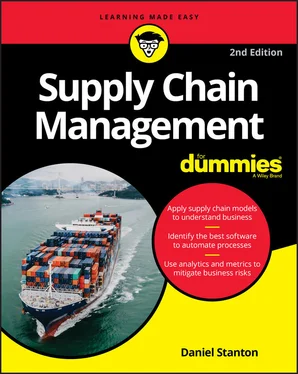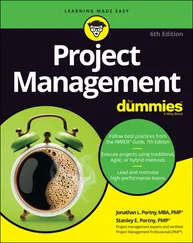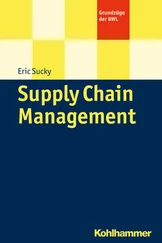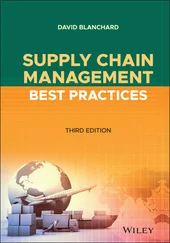The rapid evolution of technology has transformed the way that supply chains work. A few years ago, we ordered things from catalogs, mailed in checks, and waited for our packages to be delivered. Today, we order products on our phones, pay for them with credit cards or information stored in a digital wallet, and expect real-time updates until those packages are delivered to our doorsteps. Supply chain management requires understanding how technologies work and how to use them to create value at each step in the supply chain.
The ability to share information instantly and to move products around the world cheaply means that every organization today operates in a global marketplace. No matter what product or service you provide, your company is global in some way. As a supply chain manager, you must recognize how your business depends on global factors to supply inputs and drive demand for outputs. You also need to think globally about competition. After all, your company’s real competitive threat could be on the other side of the planet.
When you combine high-performance requirements with complicated technologies and dependence on global customers and suppliers, you have a recipe for chaos. Lots of variables mean that many things can go wrong. Even a small disturbance, such as a shipment that gets delayed, can lead to a series of problems farther down the supply chain — stockouts, shutdowns, penalties, and more. Managing a supply chain means being aware of risks and implementing processes to detect and mitigate threats. Stability may be the key to making supply chains work smoothly, but risk management is the key to avoiding or minimizing the costs of dealing with surprises. Done well, risk management can even provide opportunities to capture value during times of uncertainty.
You can’t manage what you can’t see, so supply chain management makes visibility a priority. Knowing what’s happening in real time (or close to real time) lets you make better decisions faster. Visibility comes at a cost, however: You have to build your supply chain in a way that lets you capture data about key steps in the process. The value of visibility is that it lets you make decisions based on facts rather than on intuition or uncertainty. Having better visibility into supply and demand allows you to optimize the amount of inventory that you hold throughout the supply chain.
Supply chain management is about creating value — meeting your customers’ needs in the right place, at the right time, at the right level of quality, for the lowest cost. This value is the heart of supply chain management. If I had to pick just one principle to describe the whole process of supply chain management, it would be value creation.
Introducing Five Supply Chain Tasks
James B. Ayers is a supply chain management expert who works with manufacturers, service companies, and government agencies. In Handbook of Supply Chain Management , 2nd Edition (Auerbach Publications, 2006), Ayers says that supply chain management should concentrate on five tasks:
Designing supply chains for strategic advantage: Consider how your supply chain can help you create value by operating better, faster, and cheaper than your competitors. Think beyond just lowering costs, and consider ways in which your supply chain can help you grow revenue, innovate, and even create new markets.
Implementing collaborative relationships: Consider how you can get teams to work together toward a goal rather than compete for conflicting objectives. If your sales team is trying to improve customer service by making sure that plenty of inventory is available, and your logistics team is trying to reduce inventory to lower costs, both teams are probably going to waste a lot of energy. Supply chain management can help them align their objectives.
Forging supply chain partnerships: Consider how you can build and sustain strong relationships with customers and suppliers. When companies understand that they depend on one another for success — and perhaps survival — working well together becomes a priority. Companies that don’t do a good job of forming and sustaining supply chain partnerships end up at a competitive disadvantage.
Managing supply chain information: Consider how you can make sure that information is shared with others in the supply chain in ways that create value for everyone. When retailers share sales data with their upstream partners, the manufacturers and distributors do a better job of scheduling production and managing inventory. When manufacturers share data about commodity prices and capacity constraints with their downstream supply chain partners, the retailers do a better job of managing pricing and promotions. Sharing the right information up and down the supply chain helps everyone create more value.
Making money from the supply chain: Consider how you can use your supply chain design, relationships, partnerships, and information to capture value for your company. At the end of the day, businesses are sustainable only if they’re able to generate a profit. In supply chains, a process change for one part often creates value for someone else. Find ways to share this value so that everyone has an incentive to work toward optimizing the value of the entire supply chain and ensuring that all the participants make a profit along the way.
Implementing the New Supply Chain Agenda
One of my favorite books about supply chain management is The New Supply Chain Agenda, by Reuben E. Slone, J. Paul Dittmann, and John T. Mentzer (Harvard Business Review Press, 2010). It’s a business book — the kind that you’d find in an airport bookstore — that breaks down the challenge of supply chain management in a way that focuses on senior executives. The authors talk about working capital and liquidity, strategy, and alignment, and they lay out a five-step system for making a company better at supply chain management. The five steps of the New Supply Chain Agenda are shown in Figure 1-4.
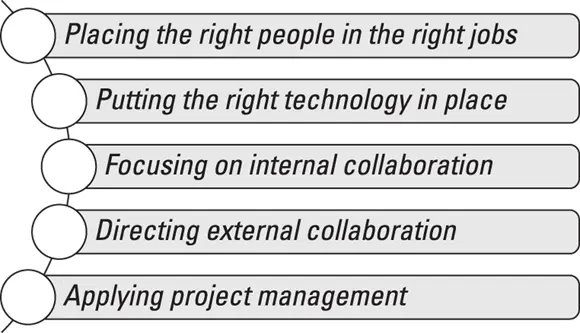
FIGURE 1-4:The New Supply Chain Agenda.
Placing the right people in the right jobs
Implementing supply chain management requires understanding how your job affects other people inside your company, as well as the people up and down the supply chain. If people don’t understand the true effect of the jobs that they do, they need to learn so that they can do their jobs better. If someone is unable to learn or doesn’t want to learn, he or she isn’t the right person for that job. Getting the right people in the right jobs is the first step in implementing an effective supply chain strategy.
Putting the right technology in place
Supply chains depend on technology. The technology may be something simple, such as a whiteboard with sticky notes that gets updated daily, or it may be something as complicated as an enterprise resource planning system. Each business, and each function within each business, has different technology needs. Figuring out how technology can enable your supply chain to create and capture value and then implementing the right technologies at the right time is the second step in the New Supply Chain Agenda.
Focusing on internal collaboration
When you look at a company’s organization chart, it’s easy to see how traditional business structures create silos within a company, with divisions competing for limited resources and often working toward conflicting goals. Managing from a supply chain perspective helps you break down the silos that keep people from collaborating effectively. By changing the focus from the performance of the separate groups to the performance of the company’s supply chain as a whole, each division becomes more dependent on the others for its own success. Sales teams need to collaborate with operations teams. Logistics teams need to collaborate with procurement teams. Everyone needs to understand the company’s strategy and work toward common goals.
Читать дальше
